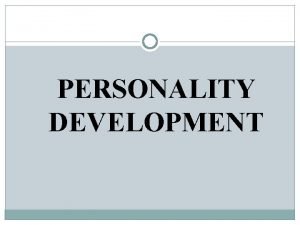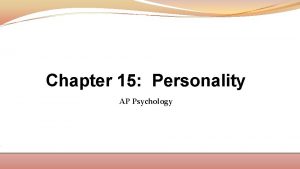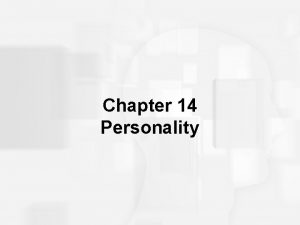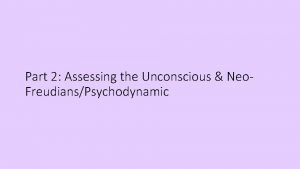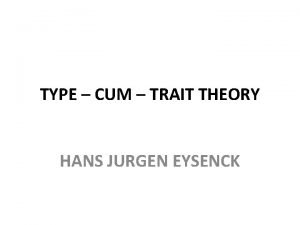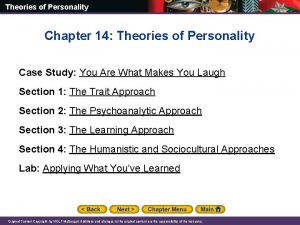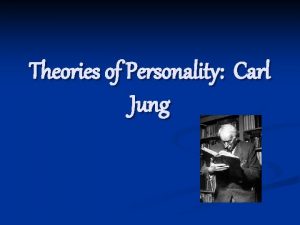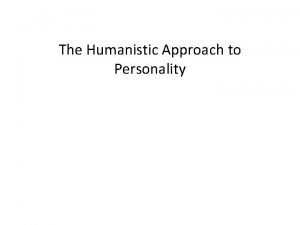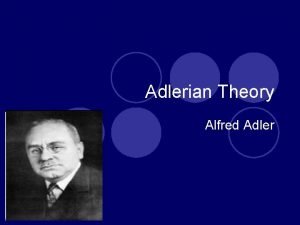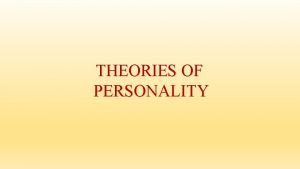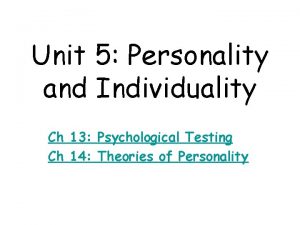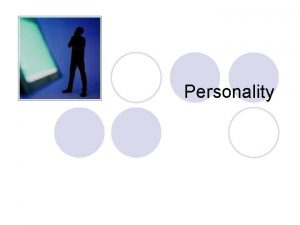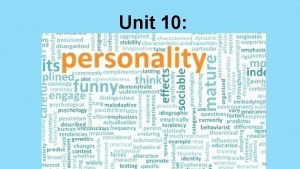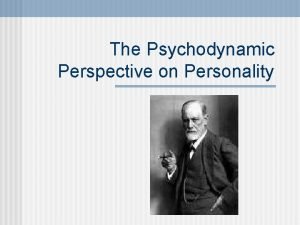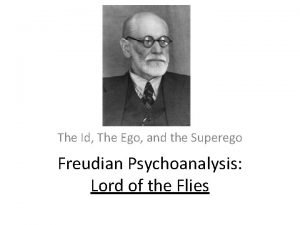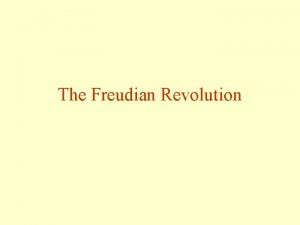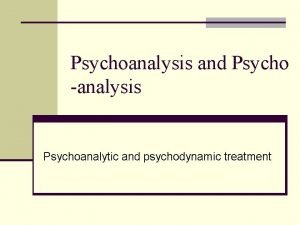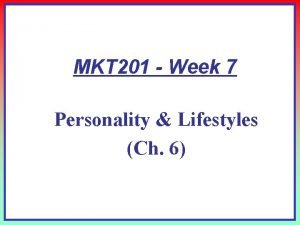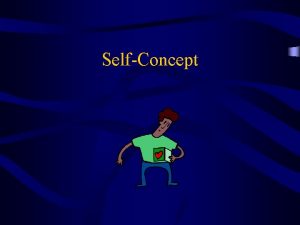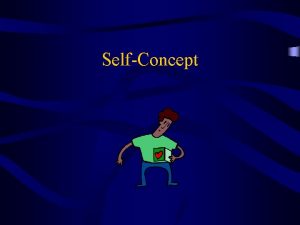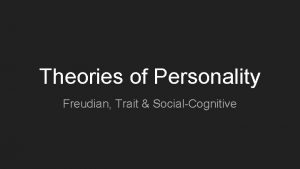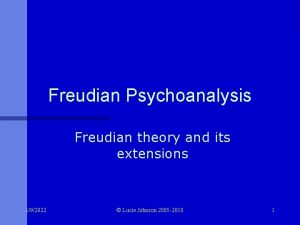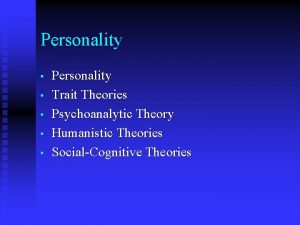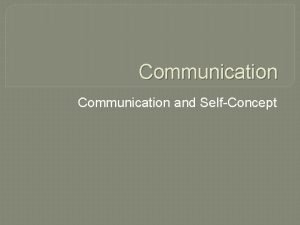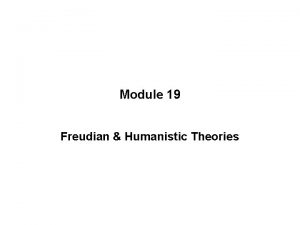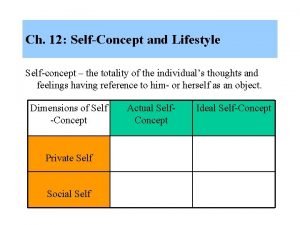THEORIES OF PERSONALITY AND SELFCONCEPT A Freudian Theory






















- Slides: 22

THEORIES OF PERSONALITY AND SELF-CONCEPT A. Freudian Theory

Eros = life instincts. Libido = energy created by the life instincts. Thanatos = death instincts.

�Id = Present at birth and operates on the pleasure principle. The id operates exclusively on the unconscious level. �Ego = Develops to find a match between the image of a needed object and a real perception of that object in the world. �Superego = Is the embodiment of parental and societal values. �Both the ego and superego operate on the unconscious, preconscious and conscious level.

� Different sexual instincts are associated with different areas of the body called errogenous zones. � Freud posited five stages of psychosexual development each of which in crucial in the development of personality structure and each centering on a different errogenous zone. These stages are the oral, anal, phallic, latency and genital. � Phallic stage is the source of gender differences in personality.

� Cannot be disproved. � Nature of the sample. � Over emphasis on biology. � The penis is a superior organ? !? ! � Myths of women disguised in scientific language.

THEORIES OF PERSONALITY AND SELF-CONCEPT Socio-biology

first proposed by E. O. Wilson. Sociobiology = The application of evolutionary theory to understanding of social behavior of animals, including humans. Fitness =The relative number of genes that are past on to the next generation. So, shares Freud's assumption that motives for behavior are unconscious and we have these instictual drives.

Males and females have different reproductive strategies to enhance their fitness. For males, there is little parental investment mate with many women as possible. For women, there is high parental investment attempts to enforce monogamy

� Feminists don't like biological explanations. � Androcentric bias that leads to a selective viewing of the evidence. � Not easily testable. � This perspective has been accused of justifying racism, sexism, homophobia.

THEORIES OF PERSONALITY AND SELF-CONCEPT Social Learning Theory

� We behave in certain ways because of learning not biologically based drives. � Blank slate or tabula rosa. � Behavior that is reinforced increases, behavior that is punished decreases.

“Give me a dozen healthy infants, wellformed, and my own specified world to bring them up in and I'll guarantee to take any one at random and train him to become any type of specialist I might select--doctor, lawyer, artist, merchant- chief, and yes, even beggarman and thief, regardless of his talents, penchants, tendencies, abilities, vocations, and race of his ancestors“ —John B. Watson, 1924

� Boys and girls learn to behave differently because they receive differential rewards and punishments. � Primary caregiver differentially reinforces her sons and daughters. � Later, other people also become sources of reinforcement for gender appropriate behaviors.

� See Handout. � Gender Typed Toys Ø Leaper, 2002 Ø Blakemore & Centers, 2005

� Imitation = You do what you see others doing. � Observation = Learning takes place even though the behavior is not performed immediately afterwards. � Children imitate same gender adults more than opposite gender adults.

� An optimistic model in the sense that has direct implications for altering young children's gender development. � If we are blank slates, why the consistency over time in what we are taught?

THEORIES OF PERSONALITY AND SELF-CONCEPT Gender-Related Personality Traits

� Agency �A vs. Communion? preference for internal vs. external space? � Society’s � Change 2000) stereotypes of men and women? in stereotypes over time (Spence & Buckner,

�Uni-dimensional = Femininity and masculinity are different ends of the same dimension. �Bi-dimensional = Femininity and masculinity are independent dimensions. �Gender consistent �Gender reversed �Androgynous �Undifferentiated

�Conceptualizes masculinity and femininity as separate dimensions, therefore, yielding a measure of androgyny. �Consists of 60 adjs. 20 masc, 20 fem, and 20 neutral filler adjectives. �Chosen on the basis of what a large sample of American males and females rated as desirable traits for each sex.

� Add up your ratings for items 1, 4, 7, 10, 13, 16, 19, 22, 25, 28, 31, 34, 37, 40, 43, 46, 49, 52, 55, 58. Divide the total by 20. This is your masculinity score. � Add up you ratings for items 2, 5, 8, 11, 14, 17, 20, 23, 26, 29, 32, 35, 38, 41, 44, 47, 50, 53, 56, 59. Divide the total by 20. This is your femininity score. � If both your masculinity and femininity scores are above 4. 9, you are androgynous.

� The general rationale (“Balance Androgyny Hypothesis”). � The masculinity effect (Woo & Oei, 2006). � Limitations of the findings with respect to masculinity (Lefkowitz & Zeldow, 2006) �Defensive deniers. �Concept of psychological adjustment.
 Sigmund freud psychoanalysis theory
Sigmund freud psychoanalysis theory Trait theory in consumer behaviour
Trait theory in consumer behaviour Freudian personality styles
Freudian personality styles Freudian personality types
Freudian personality types Theories of personality quiz
Theories of personality quiz Alfred adler collective unconscious
Alfred adler collective unconscious Trait theory of personality
Trait theory of personality Rogers view of personality
Rogers view of personality According to jung the unconscious mind is characterized by
According to jung the unconscious mind is characterized by Personality quiz
Personality quiz Adler creative self
Adler creative self Theories of personality
Theories of personality Raymond cattell was a psychologist who ________.
Raymond cattell was a psychologist who ________. Theories of personality
Theories of personality Freudian ideas
Freudian ideas Psychodynamic
Psychodynamic Freudian analysis
Freudian analysis Freudian revolution
Freudian revolution Freudian iceberg
Freudian iceberg Freudian slip meaning
Freudian slip meaning Examples of defense mechanisms
Examples of defense mechanisms Vals segmentation
Vals segmentation Freud's theories
Freud's theories
